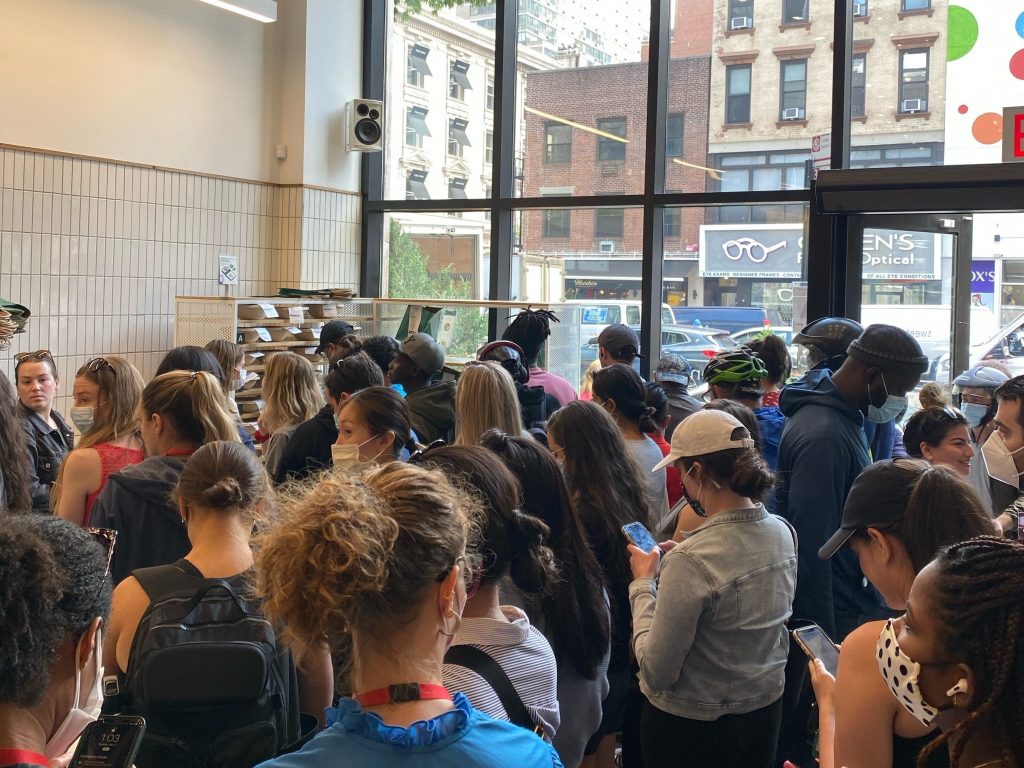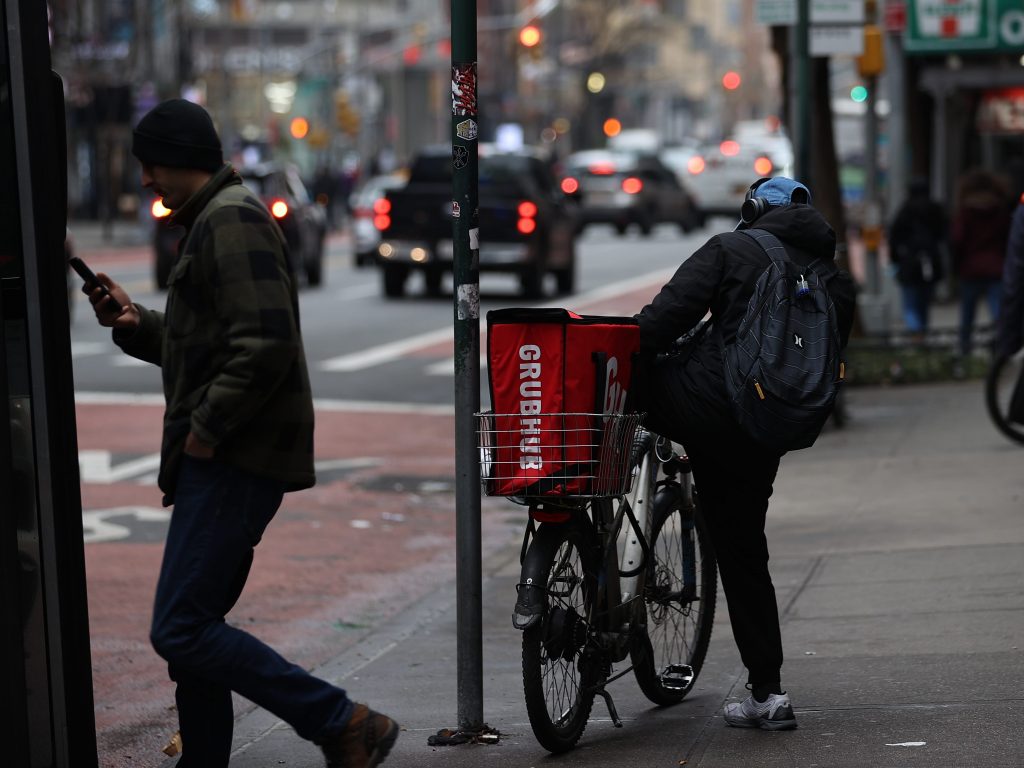- GrubHub's "free lunch for NYC" promotion generated 6,000 orders per minute on Tuesday.
- Many restaurants and delivery workers felt overwhelmed and unprepared for the tidal wave of orders.
- Long wait times led to abandoned orders, angry customers, and negative reviews, businesses told Insider.
For many New York City restaurants, Tuesday felt like the Super Bowl. Restaurant owners and workers told Insider that takeout orders piled up as some customers waited hours for their lunch. Angry customers yelled and kitchen cooks fumed.
The cause of Tuesday's mid-day chaos? GrubHub's "free lunch for NYC" promotion, which gave users $15 off any order between the hours of 11 a.m. and 2 p.m. — resulting in 6,000 orders per minute, as BuzzFeed News first reported.
"It ended up causing a five-hour wait," one Astoria restaurant worker, who asked to remain anonymous in order to speak freely, told Insider. "There were so many angry customers. We got bad reviews all because GrubHub didn't have carriers for us."
GrubHub based its order projections for Tuesday's promotion on a similar campaign that took place last year, Christopher Krautler, a spokesperson for the company, told Insider. But the actual redemption rates were six times higher than GrubHub's estimates.
"Even with that preparation, we didn't anticipate demand at this level, and unfortunately that caused strain on some restaurants," GrubHub said in a statement, adding that more than 90% of orders were fulfilled during the promotion and many restaurants experienced a ten-fold increase in new diners compared to the week prior.
Donnie D'Alessio, the owner of Astoria's popular cafe Comfortland, said bags of unclaimed food sat in the restaurant for hours on Tuesday. "People were very disappointed," he said. As he tried to assist stressed-out staff, the phone was "ringing off the hook," he added.
To cut down on the delivery queue, he went live on Instagram and offered the cafe's 50,000 followers free ice cream if they came to pick up their GrubHub orders in-person. He estimates about 20 people did out of about 150 orders total.
D'Alessio closed the restaurant early, which he estimated cost the shop a "couple thousand dollars." At around 6 p.m., D'Alessio said GrubHub drivers started reaching out about food orders placed five hours prior.
Many restaurants and delivery workers were caught off guard
Several restaurant workers and owners, including D'Alessio, told Insider they were not aware of the promotion before Tuesday's sudden surge in orders. Another worker, Frances Morel of Nish Nush, said his boss only knew about it because of a news article and alerted staff.
GrubHub told Insider it gave multiple forms of advance notice to its restaurant network over email and on the app.

Many of GrubHub's own delivery drivers were similarly caught off-guard by Tuesday's free lunch promotion, according to Hildalyn Colón Hernández, the director of policy and strategic partnerships at Los Deliveristas Unidos, a group that represents over 5,000 food delivery workers in NYC. She said the majority of her group's members were unaware of the promotion.
"This isn't like a regular workforce that you can go to an office and ask questions," she told Insider. "You depend on your phone and the app to tell you what's going on."
Gabriel, a business student who delivers food part-time and requested to only use his first name, received a notification on May 14 within GrubHub's internal messaging platform, according to screenshots viewed by Insider. The message said drivers would "have the chance to earn big on deliveries" on May 17 from 11 a.m. to 2 p.m. because of a "special deal" being offered to customers.
Gabriel worked from 11 a.m. to 1 p.m. Tuesday and earned $81.93, screenshots showed, with $35 of it coming from bonuses dependent on how many consecutive deliveries were made without canceling.
The first hour of the promotion ran smoothly on the delivery side, Gabriel said. But by noon he said the situation "deteriorated greatly" as restaurants became swamped with orders and crowds of delivery drivers formed.
Gabriel said he called it quits after a distressed owner of a small Japanese restaurant — who told him he had 400 orders when he first opened, and 600 orders by the time Gabriel arrived — asked the drivers to cancel their orders. Gabriel gladly agreed, but called GrubHub customer service in order to explain the situation to avoid having his rating downgraded.
Gabriel also noted that GrubHub's delivery model is different from other apps, such as Uber Eats. Instead of waiting for the restaurant to complete the food order before pinging the delivery drivers, the app notifies both the restaurant and driver simultaneously.
"If you have hundreds of orders because you're running a promotion, there's no way logistically it's going to work," he said. "That's a big reason why I think there was massive bottlenecks on Tuesday."
When things go wrong, who is left with the bill?
It's unclear who, between customers, restaurants, and delivery drivers, is going to literally pay the price for angry customers who never received or canceled their "free lunch." D'Alessio said he called his GrubHub representative on Tuesday to try to find out.
"They had no idea how it was going to go down," he said. "Their response was no one was really going to get refunded as far as customers go because it was free anyway."
GrubHub told Insider on Thursday that the company is reaching out to restaurant partners "to ensure that no restaurant is charged for a cancellation that was due to Grubhub drivers being unavailable to deliver orders."
"Additionally, we are reaching out to diners who applied the promo but had a canceled order and did not get their lunch with a $15 credit off their next order, to use anytime," the company said.
Hernández, of Los Deliveristas Unidos, said GrubHub's planning of the promotion highlights how delivery apps often prioritize their technology over the needs of restaurant and delivery workers.
"Computers can get thousands of orders," she said. "But if there's not enough human capital on the other side to fulfill it, it's like having nothing."
